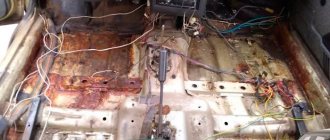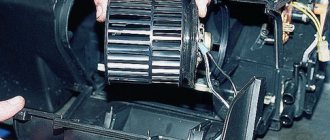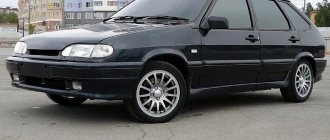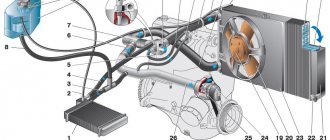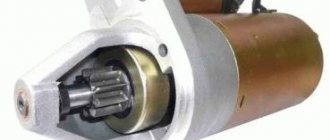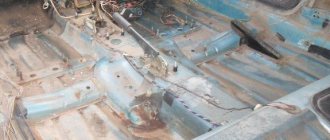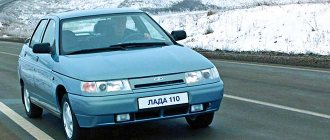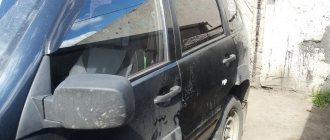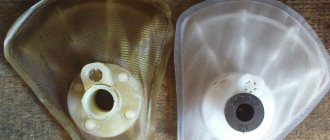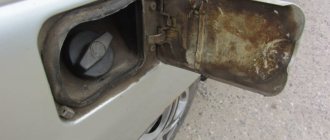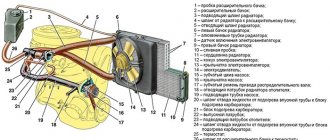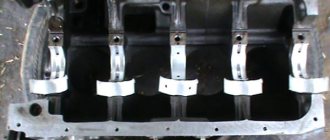Print this article Font size 16
The current condition of the car can largely be assessed by analyzing the body. If all kinds of consumables need to be replaced, you can even rebuild the suspension yourself and even install a new engine, then restoring a completely rusted body is expensive and pointless.
No one will tune, modify, or invest a lot of money in a car if its body is already in its last years. This significantly reduces the cost of the car, even if the engine is in perfect condition.
Therefore, if you want to maintain the attractive appearance of your VAZ 2110, extend its service life, and, if necessary, sell it for good money, keep an eye on the body and periodically carry out repair or preventative body work aimed at combating corrosion.
Causes of corrosion
The manufacturer does not pay enough attention to the anti-corrosion treatment of these machines (as well as sound insulation). This is evidenced by numerous reviews from owners. But if you can still put up with the noise in the cabin, then you can’t put up with the holes in the floor.
It's uncomfortable and unsafe. Accordingly, the question arises about repairing or replacing the bottom of a VAZ-2110. Experts identify several factors that significantly accelerate its wear:
- Weather. Metal rusts upon any contact with water, even if it was painted and treated at the factory. But rain is not the most destructive factor. More aggressive towards metal are the salt reagents that our road services use to sprinkle the asphalt in winter. If you don't frequently wash the underside of your car with high pressure, the salt will remain in the most hidden places. Further, rust will form in these areas, and after a year - through holes.
- Road accident. Even with a minor accident, the base layer of enamel and primer separates from the metal. If the painting was done by unqualified craftsmen, after 1-1.5 years rusty marks will form in the same place. The same problems occur if the surface was not properly prepared for painting and was poorly cleaned.
- Clogged drainage. Often, repairs to the underbody of a VAZ-2110 are required due to clogged drainage holes. Water eventually gets into the cabin and trunk. It has nowhere to go - it is absorbed into the factory carpet and soft soundproofing material. In addition to corrosion, it can cause a characteristic smell of mold and rot. Water also forms when using unsealed mats. Textile products are very popular now. But not every model retains moisture, which is why it is absorbed into the carpet and then onto the metal.
Thus, the bottom of the VAZ-2110 is exposed to negative effects from both sides. Plus, it is very difficult to find the source of the problem. Not everyone has a hole in their garage, and no one will disassemble the interior in order to identify “bugs.” They ride until the floor is soft like jelly.
When is repair required?
The first copies of the tenth family had a characteristic feature - the paintwork on the windshield frame peeled off at the top, starting from under the seal. Then this disease was overcome by changing technology, but the weaknesses remained.
Already on five- to seven-year-old cars, corrosion on the sills is very likely, and ten-year-old cars necessarily require monitoring of the bottom, arches, and side members.
Rotten thresholds
They accelerate the appearance of rust and through corrosion, damage in road accidents followed by incomplete or unqualified repairs, difficult operating conditions on bad roads in winter and in bad weather, storage in conditions of high humidity.
Regular anti-corrosion treatment done at a service center or with your own hands will help extend the life of body parts; it is especially necessary for the hidden cavities of the sills and side members, this power “skeleton” of the car.
The bottom is corroded on both sides. From below he is attacked by dirt and water from the road. If the anti-gravel coating is damaged, the first spots appear literally within a year; after 2–3 years, with intensive use, corrosion becomes through.
Through corrosion of the bottom
In the cabin there is a carpet on the floor, under which there are layers of vibration-insulating and noise-absorbing materials. If water or snow gets into the bottom trough, for example from shoes, the coating gets wet and does not dry well. Increased constant humidity leads to corrosion of the bottom from the inside of the cabin and the need for repairs. To prevent this, use rubber mats with sides, and make sure that no water gets into the interior during rain or when washing.
Corrosion due to moisture under soundproofing material
A rotten bottom is revealed when viewed from below; under a layer of putty or anti-gravel, the holes may not be visually noticeable, but light blows with a hammer or pricks with an awl will immediately reveal the defect. Corrosion most often appears along the sills and in the driver's and front passenger's feet.
In the cabin, poor condition of the bottom will be indicated by sagging of the floor under your feet under load, in extreme cases, the breakdown or impossibility of fixing the driver's seat. And, of course, there is a frequently encountered situation when, when lifting a car on a jack, the special thrust pads for the jack break due to corrosion.
Tools
To successfully repair the underbody of a VAZ-2110 with your own hands, we will need a welding machine and a mask. Electrodes will not work: the metal is very thin and there is a risk of burning it. Therefore, only a semi-automatic machine and welding wire are used. We will also need a grinder (preferably small) and a circle for cutting metal. Among other materials, you should prepare sheets of sandpaper (or an appropriate drill attachment), primer, paint, anti-corrosive agent, and rust converter. At the end of the repair process, the bottom of the VAZ-2110 will need to be “noisy”. But it is useless to use old material. Therefore, we buy new sheets of vibroplast (preferably 3 mm) and glue it onto the restored surface.
Anti-gravel compounds
Anti-gravel is often produced under foreign brands and comes in black, gray and white. The most well-known brands of this product for treating the lower part of the bottom:
- Tectyl Bodysafe;
- Tectyl Zinc Bodysafe;
- Dinitrol 479;
- Protex;
- Mercasol 3;
- Liqui Moly.
The anti-corrosion material Dinitrol 479 is often called “liquid fender liners” and is used to treat both wheel arches and the outside of the car’s underbody. Usually the product is sold in liter and 5-liter jars; Dinitrol is based on polymer rubber. The anticorrosive color is black, the manufacturer guarantees the reliability of the coating for seven years.
Let's get to work. Preparation
So first we need to prepare the car. We drive it into the garage and dismantle the interior. It is advisable that the room has an inspection hole. Depending on the scale of the work, we will need to remove one or more seats, as well as part of the carpeting, which comes standard from the factory.
At the next stage, we cut out the rotten sections of the floor with a grinder. We also cut out the metal whose thickness is less than the factory thickness - after repair it can rust again.
Please note that fuel and brake pipes, as well as the exhaust system, run under the bottom.
And the tank is hidden under the rear sofa. If a major overhaul is being carried out, all these elements should be dismantled.
Next, carefully clean all the seams with sandpaper. You can use a special drill attachment. The remaining traces of rust are treated with a zinc converter. Be careful: he is very aggressive. Therefore, we work exclusively in protective gloves.
If the scale of the work is very large and almost the entire element had to be cut off to restore the bottom of the VAZ-2110, it is important to ensure the rigidity of the body. We install wood spacers in the doorways.
Preparatory actions
You can remove rust on a car fender using improvised means or use the services of specialists. Before carrying out such an event, you should take care of preparing the car and purchasing the necessary tools:
- a grinding machine will allow you to recoup costs and help clean the vehicle body;
- sandblasting machine is the main tool in the fight against corrosion and its prerequisites. The car should be placed in a separate area to avoid damage to the garage or other buildings, since sand under the pressure of the device can fly in different directions;
- a situation with a limited budget involves the purchase of a metal brush.
Rust converters
The best chemicals to buy are: rust converter, degreaser, putty, and anti-corrosion primer.
Welding work
Overcooking the bottom of the VAZ-2110 begins with de-energizing the on-board network. You need to disconnect both terminals from the battery, otherwise you can burn the ECU and other important units. Next, we connect the ground of the welding machine to the body and get to work.
You can use patches of the appropriate size or purchase ready-made floor parts (especially when it comes to thresholds). Welding the bottom of a VAZ-2110 involves restoring:
- Floor panels.
- Crossbar.
- Support platforms.
- Extensions of side members and sills.
- Connectors.
All new sheets are carefully grabbed from below. The seam should not be continuous, but in increments of 5-6 centimeters. The body geometry should be checked periodically. If you do not take this point into account, after repair you may end up with doors that won’t close. Upon completion of the work, the seam can be made continuous.
But the repair of the VAZ-2110 underbody does not end there.
Illegal refusal to pay for old damage
If the insurer tries to deduct what is not deductible or completely refuses compensation under compulsory motor liability insurance, justifying this on the fact that they were received earlier, then you can and should defend your case.
First of all, you will need to spend money on an independent examination. The expert will need to indicate the reason for which it is being carried out - in this case, he will additionally perform an automotive technical examination. It is paid, but if you win in court, the money for it will be returned to you by the insurance organization.
If compensation is not received or the insurer ignores such a claim, a claim must be filed in court. At this stage (and possibly earlier), it is better to contact an independent expert lawyer who can correctly draw up a statement of claim to the court and consistently present the necessary rules of law and facts in the case in the courtroom.
What's next?
Then we apply primer and paint. We treat the metal on both sides with bitumen mastic or gun lard. Due to their greasy consistency, these compounds will repel water and prevent it from penetrating inside the metal.
Additionally, you can apply an anti-gravel coating (if the metal is treated with mastic and not lard). After the composition has dried, we soundproof the interior. Sheets with vibroplast must be laid on a clean surface. It doesn't stick to dirt. But it will adhere fully to sticky mastic. Additionally, we roll the sheet with a special roller or with our hands through a rag. Then you can safely assemble the interior and install the seats.
Description of the design of VAZ 2112 thresholds
The Lada 2112 was produced from the factory assembly line with permanent sills. The part was welded to the bottom of the body and formed a single whole with the same unit, like a sidewall. Installation on the sidewall occurs by spot welding. Considering that the latest model is 11 years old, many bodies have undergone planned and independent alterations. The fixed sills were removed, the bottom was strengthened, and the side members were reinstalled.
Some craftsmen replaced factory iron with double galvanized profile steel. Structurally, the thresholds on the VAZ 2112 are a hollow box consisting of three parts:
- The outer box is the visible part that is located under the doors and goes into the wheel arch.
- Internal amplifier. The part is considered a load-bearing element and provides the necessary rigidity.
- Connector. In the factory configuration, two connectors were used, an internal element that connected the bottom and the amplifier, and an external one, which connected the outer trim and the bottom.
Replacing the threshold for Zhiguli 80% involves the use of welding. When repairing at a service station, spot and gas welding machines are used; when doing self-repair, it is better to use a semi-automatic machine. The tool is easier to use, the instruction manual is designed for beginners.
How to extend the life of the bottom?
These tips are suitable for those who have already repaired the floor on the “ten”, and those who still have a living copy. So, the first rule is frequent washing. Typically, car owners pay attention to the upper part of the body. But you also need to wash its hidden cavities. This is especially true for those who live in large cities and operate their cars in winter. The stuck salt will not go away until it is removed with a powerful stream of water.
The next rule is regular treatment of the bottom. Over time, the old anticorrosive agent is washed out and peels off. Once a year you need to check its condition and, if necessary, renew the layer. If pockets of corrosion have already appeared on the surface (but not through), we treat them with a converter, and then with a thick layer of mastic. As for the thresholds, they have drainage holes. There is no point in treating them externally with anti-corrosion agent - the water is inside. Therefore, in dry and warm weather, we take a can of Movil and pour it through a thin tube (it usually comes included) inside. After a year, this procedure should be repeated. This is the only way to ensure complete protection against rust for the bottom and sills. If the problem occurs in winter, you can apply a temporary measure - clean the rusty surface and apply anti-corrosive agent locally to the area. And with warming, treat the entire perimeter.
Types of damage
Before removing corrosion damage, it is worth finding out its cause. There are five types of rust:
- cosmetic rust forms in areas where car parts come into contact with the body (lights, moldings and radiator grille);
- under-film occurs in the lower part of the coating and is a pronounced defect (the paint turns into bubbles);
- the through type is formed in the final stage of corrosion - holes appear that spoil the metal;
- pinpoint damage destroys the inner layer of the car's surface;
- Rust spots can cover most of the body and wing of a vehicle; it is recommended to remove errors at the stage of their formation.
VAZ 2110 body diagram and dimensions
| Body length including bumpers, cm | 426,5 |
| Wheelbase length, cm | 249,2 |
| Height when loaded, cm | 142 |
| Distance from the front axle to the end of the bumper, mm | 829 |
| Distance from the rear axle to the end of the bumper, mm | 944 |
| Body width, cm | 168 |
| Vehicle weight, kg | 1020 |
| Body weight, kg | 260 |
| Distance between the tips of the side mirrors, cm | 187,5 |
| Front track, cm | 140 |
| Rear track, cm | 137 |
| Maximum ground clearance (empty car), cm | 18 |
| Ground clearance (car loaded and driver), cm | 17 |
| Minimum ground clearance (driver, 4 passengers and luggage), cm | 16,5 |
Bodies and what they are like
ATTENTION! A completely simple way to reduce fuel consumption has been found! Don't believe me? An auto mechanic with 15 years of experience also didn’t believe it until he tried it. And now he saves 35,000 rubles a year on gasoline! Read more"
As you know, the body on the “ten” is load-bearing and repeats the basic design of any modern passenger car. Today it is customary to talk about several types of bodywork. The frame and supporting body are considered the main ones.
The difference between frame and load-bearing
How much does the body of a VAZ 2110 weigh?
All the main components of the car are located on the frame; it serves as a support and is itself fixed to the wheels of the car by means of suspensions. If you pay attention to trucks, then the frame can be seen with the naked eye, and thus you can draw appropriate conclusions about its structure. In “passenger cars” there is no frame, or it would be more accurate to say that on some passenger cars the frame-body assortment forms a single whole, called the body.
Frameless bodies, which include the metal frame of the VAZ 2110, are made in such a way as to withstand the mass of numerous heavy components. For this purpose, the body floor is well reinforced, and most of the overall parts are made of materials with a lightweight base.
On frameless bodies, the role of the frame is performed by the spars. They can be said to be responsible for the massiveness of the entire body structure. From time to time, these components are subjected to unplanned and shock loads that change very quickly in different directions. This operating scenario cannot have a positive effect, and over time, the welding points break, the bolts become loose, and the solidity of the entire body structure weakens.
VAZ 2110 body diagram
The car body also feels the load from a running engine. It vibrates strongly, although the engine itself and the cylinders are designed to absorb some of the vibrations. To minimize the effects of vibrations on the body, manufacturers use special cushions or dampers, as well as washers made of dense rubber.
Note. The effect of these pads can be clearly determined by monitoring the operating unit with the hood open. The engine “growls” and shakes, but the body doesn’t care.
The most important task of a frameless car body is to transport luggage and passengers. At the same time, the machine must also provide major protection. The number of people transported and the weight of the permissible load are determined by the designers responsible for the layout and other parameters of the body.
If you imagine the frame of a “car” in the form of its components, then its main parts are three main zones, implying the trunk, the passenger compartment and the front. The finished look of the solidity of the frame is given by its hinged parts or “plumage”, which includes various panels.
Body types of the “tenth” family
VAZ 2110 body diagram
The difference in body types, again, is associated with what one or another model is intended for. The car may be intended for off-road travel, and then it will be designed as a crossover or a full-fledged all-terrain vehicle, or it may be intended only for city driving.
Note. The body of the VAZ 2110 is a typical sedan. Models associated with the “ten” already have other body types: 2111 – station wagon, 2112 – 5-door hatchback, 21123 – coupe or 3-door hatchback.
It will be useful to know that over the entire production period of the 2110 model, VAZ creates many variations of this sedan. In particular, the Consul limousine, with an even longer wheelbase, deserves attention.
The design of the sedan began immediately after the VAZ 2108 became obsolete, when the plant decided to replace the project. But the release of the “ten” was not yet imminent. The fact is that the designers made many revolutionary improvements that significantly increased the cost of the project. Due to the economic crisis that reigned in the country at that time, the project was moved forward several years, and only in 1995 mass production of the “ten” began.
VAZ 2110 body diagram of station wagon 2111
The sedan is the classic and most popular body style of modern cars. The interior includes 2 rows of seats and usually accommodates 4-5 people including the driver. The luggage compartment in sedans is properly separated from the interior.
For many, to this day, the question of the merits of the VAZ 2110 car is somewhat controversial. It is clear that it cannot compare with foreign cars, but the presence of “ten” running on the roads of our country speaks volumes.
Dimensions and how much it weighs
The body length of the “ten” sedan is 4265 mm, which is only slightly less than the “universal” dimensions. This length looks the most organic not only among the models of the “tenth” family, but also in VAZ as a whole.
Instructions for VAZ 2110 body dimensions and repairs
We also note that the length of the “ten” is 6 cm longer than the length of the only “Samarov” sedan - VAZ 21099. The same goes for other parameters:
- The longitudinal distance between the wheel axles is 3.2 s longer;
- Body height is 1.8 cm higher;
- Ground clearance is 5 cm higher.
But both gauges are the same for “99” and “tens”. In addition, both models have similar gearboxes and engines. But still, in general, the technical characteristics of the “tens” and “99” are different. The “Ten” is able to achieve better speed and demonstrate enviable maneuverability on the road compared to the “99”, precisely due to the body design, made with modernizations and significant improvements. In particular, these are smooth body lines and completely modernized control systems.
Due to the greater length, which experts called “ideally sufficient,” the trunk of the VAZ 2110 sedan becomes very spacious. Its usual layout is 415 liters, which is already the envy of competitors.
Dimensions 2110
The large volume of the luggage compartment allows you to transport by car not only the essentials, including a spare wheel and tools, but also many additional things. If you remove the rear seats, turning the rear of the cabin into an additional trunk, you can transport up to 1270 liters of cargo.
The wheelbase of the “ten” is 2492 mm, which is also very good. If we add to this the length of the trunk - 944 mm, then on a long journey, if you have a sleeping mattress, you can make a quite comfortable bed.
VAZ's new sedan is wider, taller and longer, but also heavier than the standard family of cars (1020 kg). This was to be expected, because the designers sought to increase the interior space, thereby increasing the comfort of people sitting in the cabin.
